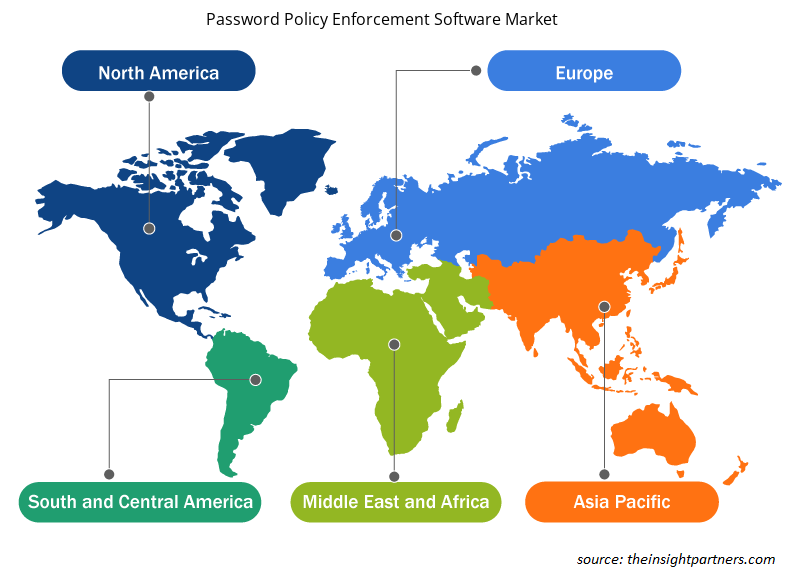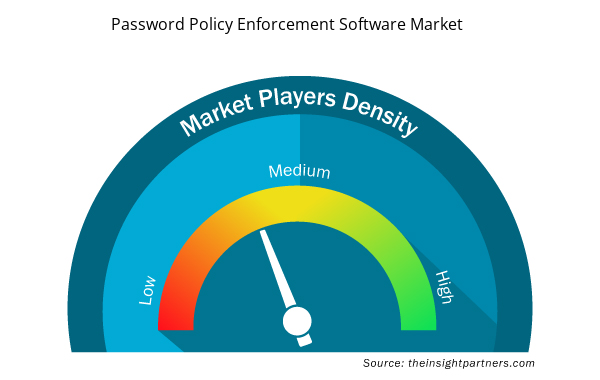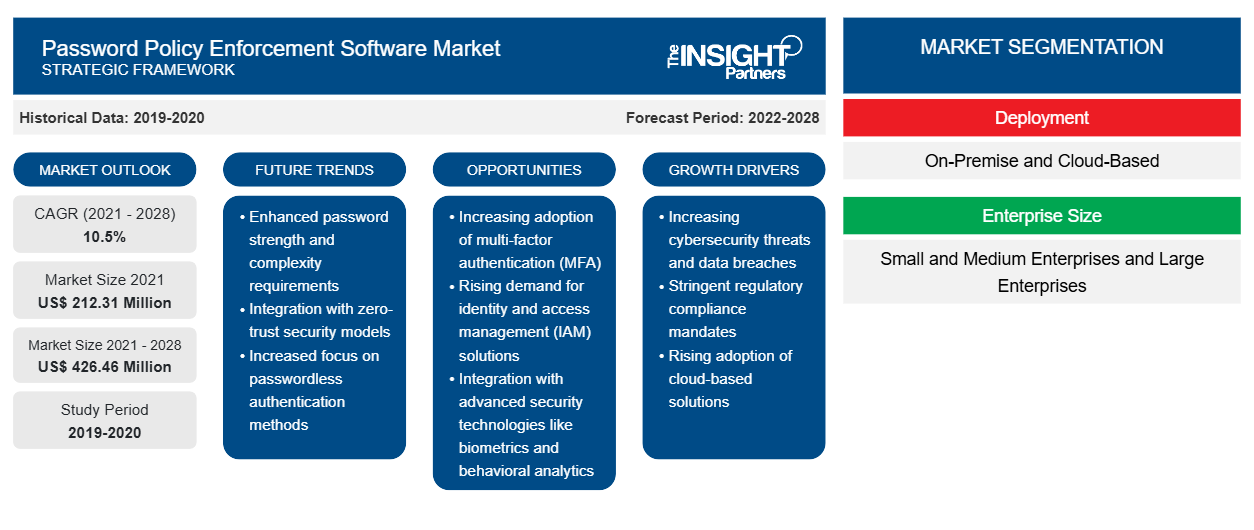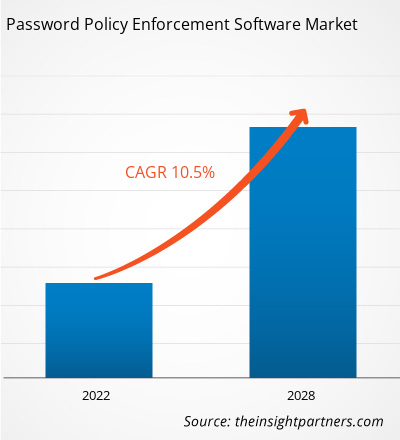Der Markt für Software zur Durchsetzung von Kennwortrichtlinien wurde im Jahr 2021 auf 212,31 Millionen US-Dollar geschätzt und soll bis 2028 426,46 Millionen US-Dollar erreichen. Von 2021 bis 2028 wird ein durchschnittliches jährliches Wachstum von 10,5 % erwartet.
Softwarelösungen zur Durchsetzung von Kennwortrichtlinien stellen sicher, dass auf allen Plattformen eines Unternehmens sichere Kennwörter verwendet werden. Organisationen installieren Software zur Durchsetzung von Kennwortrichtlinien, damit die entsprechenden Benutzer Kennwörter erstellen können, die den Beschränkungen der Kennwortrichtlinien des Unternehmens in Bezug auf Kennwortkomplexität, Symbole, Zahlen, Groß- und Kleinbuchstaben sowie Mindest- und Höchstzeichen entsprechen. Die Beschränkungen stellen außerdem sicher, dass Kennwörter keine häufig verwendeten Wörter, Ausdrücke oder Kennwörter, vom Unternehmen festgelegte Wörter auf der schwarzen Liste oder Kennwörter aus bekannten Hackerwörterbüchern enthalten.
Mehrere digitale Anbieter sind mit vereinfachten Angeboten für verschiedene Branchen in den Markt für Software zur Durchsetzung von Kennwortrichtlinien eingestiegen . So bietet beispielsweise die Netwrix Corporation vereinfachte Software zur Durchsetzung von Kennwortrichtlinien an, die selbst die kompliziertesten Anforderungen an Kennwortrichtlinien erfüllt, indem sie Benutzern, Domänengruppen und Organisationseinheiten ermöglicht, bis zu 256 lokale und Domänenkennwortregeln festzulegen.
Nordamerika ist einer der wichtigsten Märkte für Software zur Durchsetzung von Passwortrichtlinien. Darüber hinaus wird erwartet, dass kontinuierliche technologische Verbesserungen in den Bereichen Analytik, Cloud und BYOD-Trends dem regionalen Markt einen großen Aufschwung verleihen. Darüber hinaus hat eine zunehmende Häufigkeit von Cyberangriffen Bedenken hinsichtlich der Passwortsicherheit ausgelöst, was zum Wachstum des Marktes für Software zur Durchsetzung von Passwortrichtlinien beiträgt.
Passen Sie diesen Bericht Ihren Anforderungen an
Sie erhalten kostenlos individuelle Anpassungen an jedem Bericht, einschließlich Teilen dieses Berichts oder einer Analyse auf Länderebene, eines Excel-Datenpakets sowie tolle Angebote und Rabatte für Start-ups und Universitäten.
- Holen Sie sich die wichtigsten Markttrends aus diesem Bericht.Dieses KOSTENLOSE Beispiel umfasst eine Datenanalyse von Markttrends bis hin zu Schätzungen und Prognosen.
Auswirkungen der COVID-19-Pandemie auf den Markt für Software zur Durchsetzung von Kennwortrichtlinien
Die enorme Verbreitung von SARS-CoV-2 veranlasste die Regierungen verschiedener Länder, strenge Beschränkungen für die Bewegung von Fahrzeugen und Menschen zu verhängen. Die daraus resultierenden Reiseverbote, Massensperren und Geschäftsschließungen, die von den Regierungen verhängt wurden, wirkten sich insbesondere im Jahr 2020 auf die Volkswirtschaften und Industrien verschiedener Länder aus. Die verhängten Sperren reduzierten auch die Produktion von Rohstoffen, Waren und Dienstleistungen. Im Gegenteil, die COVID-19-Pandemie trug zum Wachstum des Marktes für Software zur Durchsetzung von Kennwortrichtlinien im Jahr 2020 bei, da Millionen von Mitarbeitern von ihren Unternehmen aufgefordert wurden, von zu Hause aus zu arbeiten. Die Einhaltung solcher standardmäßigen Schutzmaßnahmen hat zu einem Anstieg der Nutzung von Netzwerken, digitalen Plattformen und persönlichen Computergeräten von Drittanbietern geführt. Solche Netzwerkkonnektivitätslösungen erhöhen das Risiko von Datenschutzverletzungen und anderer Malware. Aufgrund des erhöhten Risikos von Cyberkriminalität suchen Unternehmen nach Software zur Durchsetzung von Kennwortrichtlinien, um abnormales Verhalten in den Netzwerken zu erkennen und zu verwalten.
Markteinblicke – Markt für Software zur Durchsetzung von Kennwortrichtlinien
Fortschritte auf dem Markt für Software zur Durchsetzung von Kennwortrichtlinien
Während es einen wachsenden Trend zu alternativen Authentifizierungsmethoden gibt, finden Passwörter eine Lösung, um „koexistieren“ zu können, und Passwörter sind auf absehbare Zeit notwendig. Bevor ausgefeilte Lösungen einfach eingesetzt werden können, müssen vorhandene Passwörter durch neuere Standards wie Biometrie und Multi-Faktor-Authentifizierung ergänzt werden . Die Tatsache, dass Passwörter nicht stark genug sind, um allein zu bestehen, untergräbt nicht ihre Bedeutung in Bezug auf die Sicherheit. Selbst wenn Passwörter auf dem Rückzug sind, sollten Unternehmen also an ihren Richtlinien festhalten und sicherstellen, dass ihre Mitarbeiter eine Passworthygiene praktizieren. Passwörter werden verwendet, um Zugang zu Technologie zu erhalten. Aufgrund von Technologien wie Apples Touch ID hat die passwortlose Bewegung einen technologischen Wendepunkt erreicht: Die Technologie schreitet voran und Kunden wurden auf biometrische Authentifizierung vorbereitet. Die Vorteile passwortloser Setups gehen über physische Formfaktoren hinaus. Benutzer können sich per Gesicht, Berührung oder Stimme identifizieren, aber Systeme können jetzt auch räumliche Kennungen enthalten. Verhaltensanalysen sind schwieriger zu kompromittieren und für den Benutzer weniger umständlich.
Darüber hinaus reagieren Benutzer bei der Implementierung eines neuen Sicherheitssystems immer negativ auf Unbekanntheit oder wahrgenommene Mehrkosten. Zwei-Faktor- und Multi-Faktor-Authentifizierung erfreuen sich jedoch zunehmender Beliebtheit und zahlen sich für diejenigen aus, die sie verwenden. Daher wird erwartet, dass Fortschritte bei der Software zur Durchsetzung von Kennwortrichtlinien das Marktwachstum für Software zur Durchsetzung von Kennwortrichtlinien in naher Zukunft vorantreiben werden.
Bereitstellungsbasierte Einblicke
Basierend auf dem Bereitstellungstyp kann der Markt für Software zur Durchsetzung von Kennwortrichtlinien in On-Premises und Cloud-basierte Software unterteilt werden. In der heutigen IT-Welt von Unternehmen müssen zahlreiche Überlegungen angestellt werden, bevor entschieden wird, ob eine Cloud-Infrastruktur perfekt passt. Andererseits sind viele Unternehmen nicht in der Lage, den Übergang zur Cloud zu vollziehen und verlassen sich stattdessen für ihre Geschäftstätigkeit auf ihre bewährten Legacy- und On-Premise-Systeme und -Software.
Erkenntnisse basierend auf der Unternehmensgröße
Basierend auf der Unternehmensgröße wird der Markt für Software zur Durchsetzung von Kennwortrichtlinien in kleine und mittlere Unternehmen sowie in große Unternehmen unterteilt. Kleine und mittlere Unternehmen (KMU) sind Unternehmen, deren Umsatz, Vermögen oder Personal unter einem bestimmten Schwellenwert liegen. Kleine und mittlere Unternehmen (KMU) werden in jedem Land anders definiert. Trotz ihrer geringen Größe spielen KMU eine wichtige Rolle in der Wirtschaft. Sie sind deutlich zahlreicher als Großkonzerne, beschäftigen eine riesige Belegschaft und sind unternehmerisch tätig, was zur Gestaltung von Innovationen beiträgt.
Regionale Einblicke in den Markt für Software zur Durchsetzung von Kennwortrichtlinien
Die regionalen Trends und Faktoren, die den Markt für Software zur Durchsetzung von Kennwortrichtlinien während des gesamten Prognosezeitraums beeinflussen, wurden von den Analysten von Insight Partners ausführlich erläutert. In diesem Abschnitt werden auch Marktsegmente und Geografie für Software zur Durchsetzung von Kennwortrichtlinien in Nordamerika, Europa, im asiatisch-pazifischen Raum, im Nahen Osten und Afrika sowie in Süd- und Mittelamerika erörtert.

- Erhalten Sie regionale Daten zum Markt für Software zur Durchsetzung von Kennwortrichtlinien
Umfang des Marktberichts zur Durchsetzung von Kennwortrichtlinien
| Berichtsattribut | Details |
|---|---|
| Marktgröße im Jahr 2021 | 212,31 Millionen US-Dollar |
| Marktgröße bis 2028 | 426,46 Millionen US-Dollar |
| Globale CAGR (2021 - 2028) | 10,5 % |
| Historische Daten | 2019-2020 |
| Prognosezeitraum | 2022–2028 |
| Abgedeckte Segmente | Nach Bereitstellung
|
| Abgedeckte Regionen und Länder | Nordamerika
|
| Marktführer und wichtige Unternehmensprofile |
|
Dichte der Marktteilnehmer für Software zur Durchsetzung von Kennwortrichtlinien: Die Auswirkungen auf die Geschäftsdynamik verstehen
Der Markt für Software zur Durchsetzung von Kennwortrichtlinien wächst rasant. Dies wird durch die steigende Nachfrage der Endbenutzer aufgrund von Faktoren wie sich entwickelnden Verbraucherpräferenzen, technologischen Fortschritten und einem größeren Bewusstsein für die Vorteile des Produkts vorangetrieben. Mit der steigenden Nachfrage erweitern Unternehmen ihr Angebot, entwickeln Innovationen, um die Bedürfnisse der Verbraucher zu erfüllen, und nutzen neue Trends, was das Marktwachstum weiter ankurbelt.
Die Marktteilnehmerdichte bezieht sich auf die Verteilung der Firmen oder Unternehmen, die in einem bestimmten Markt oder einer bestimmten Branche tätig sind. Sie gibt an, wie viele Wettbewerber (Marktteilnehmer) in einem bestimmten Marktraum im Verhältnis zu seiner Größe oder seinem gesamten Marktwert präsent sind.
Die wichtigsten Unternehmen auf dem Markt für Software zur Durchsetzung von Kennwortrichtlinien sind:
- VerwaltenEngine
- Avatier
- Hitachi ID Systems Inc.
- Netwrix Corporation
- nFront Security Inc.
Haftungsausschluss : Die oben aufgeführten Unternehmen sind nicht in einer bestimmten Reihenfolge aufgeführt.

- Überblick über die wichtigsten Akteure auf dem Markt für Software zur Durchsetzung von Kennwortrichtlinien
Die Akteure auf dem Markt für Software zur Durchsetzung von Kennwortrichtlinien konzentrieren sich hauptsächlich auf die Entwicklung fortschrittlicher und effizienter Produkte.
- Im Jahr 2021 erwarb Netwrix PolicyPak, um sein Angebot um Endpunktsicherheit zu erweitern. Diese Übernahme soll das Produktportfolio von Netwrix stärken und die Sicherheit und Kontrolle über privilegierte Konten in den kommenden Jahren auf Desktops ausweiten. PolicyPak und Netwrix bieten gemeinsam Lösungen für Organisationen zur Sicherheit gegen Cyberangriffe und Hacker.
- Im September 2020 gab ManageEngine bekannt, dass ADSelfService Plus jetzt die Multi-Faktor-Authentifizierung unterstützt, um Organisationen vor unbefugtem Zugriff auf ihre Daten zu schützen.
Globaler Markt für Software zur Durchsetzung von Kennwortrichtlinien – Unternehmensprofile
- Avatier
- Hitachi ID Systems, Inc.
- Netwrix Corporation
- nFront Security, Inc.
- safepass.me
- Specops Software
- Tools4ever (Passwortkomplexitäts-Manager (PCM))
- Zoho Corp (ManageEngine)
- JumpCloud Inc.
- Enzoisch.
- Historische Analyse (2 Jahre), Basisjahr, Prognose (7 Jahre) mit CAGR
- PEST- und SWOT-Analyse
- Marktgröße Wert/Volumen – Global, Regional, Land
- Branche und Wettbewerbsumfeld
- Excel-Datensatz



Report Coverage
Revenue forecast, Company Analysis, Industry landscape, Growth factors, and Trends

Segment Covered
This text is related
to segments covered.

Regional Scope
North America, Europe, Asia Pacific, Middle East & Africa, South & Central America

Country Scope
This text is related
to country scope.
Häufig gestellte Fragen
The global password policy enforcement software market was dominated by the large enterprises segment in 2020. Large enterprises are known to invest in innovative and latest technologies to operate their business effectively. With the growing capabilities of Password Policy Enforcement Software market tools across various industries, adoption of these tools has gained traction over the past few years. Large enterprises are utilizing various analytical tools such as Password Policy Enforcement Software, to effectively streamline the business operations.
The major companies in password policy enforcement software market includes Enzoic; Avatier; Specops Software; Safepass.me; and Zoho Corp (MANAGEENGINE).
In 2020, North America led the market with a substantial revenue share, followed by Europe and Asia Pacific. Asia Pacific is a prospective market for password policy enforcement software market manufacturers.
The global password policy enforcement software market was dominated by the cloud-based deployment segment in 2020. The key element attributed to the segmental growth is the high availability of cloud-based password policy enforcement software to keep vital business systems operating safely despite single component failures. Due to ongoing monitoring, geo-redundancy, and failover mechanisms, the cloud-based data and apps are ready to serve the workforce.
Businesses are progressively implementing security measures such as monitored accounts to improve responsibility. Such shift toward internet-based service offerings is driving the need for password policy enforcement software. Further, the need to comply with tight compliance standards and the rising risk of data theft in the BFSI, healthcare, and public sectors, among others, is further driving the password policy enforcement market.
Rising use of password blacklist or dictionary hack provide the opportunity for the password policy enforcement software solution providers. A well-designed system can check billions of passwords in milliseconds without impacting the user experience. It may also be good to divide the blacklist between passwords that have been disclosed in recent data breaches and those that are regularly found in cracking dictionaries.
Trends and growth analysis reports related to Technology, Media and Telecommunications : READ MORE..
The List of Companies - Password Policy Enforcement Software Market
- ManageEngine
- Avatier
- Hitachi ID Systems Inc.
- Netwrix Corporation
- nFront Security Inc.
- safepass.me
- Specops Software
- Tools4ever
- JumpCloud Inc.
- Enzoic
The Insight Partners performs research in 4 major stages: Data Collection & Secondary Research, Primary Research, Data Analysis and Data Triangulation & Final Review.
- Data Collection and Secondary Research:
As a market research and consulting firm operating from a decade, we have published and advised several client across the globe. First step for any study will start with an assessment of currently available data and insights from existing reports. Further, historical and current market information is collected from Investor Presentations, Annual Reports, SEC Filings, etc., and other information related to company’s performance and market positioning are gathered from Paid Databases (Factiva, Hoovers, and Reuters) and various other publications available in public domain.
Several associations trade associates, technical forums, institutes, societies and organization are accessed to gain technical as well as market related insights through their publications such as research papers, blogs and press releases related to the studies are referred to get cues about the market. Further, white papers, journals, magazines, and other news articles published in last 3 years are scrutinized and analyzed to understand the current market trends.
- Primary Research:
The primarily interview analysis comprise of data obtained from industry participants interview and answers to survey questions gathered by in-house primary team.
For primary research, interviews are conducted with industry experts/CEOs/Marketing Managers/VPs/Subject Matter Experts from both demand and supply side to get a 360-degree view of the market. The primary team conducts several interviews based on the complexity of the markets to understand the various market trends and dynamics which makes research more credible and precise.
A typical research interview fulfils the following functions:
- Provides first-hand information on the market size, market trends, growth trends, competitive landscape, and outlook
- Validates and strengthens in-house secondary research findings
- Develops the analysis team’s expertise and market understanding
Primary research involves email interactions and telephone interviews for each market, category, segment, and sub-segment across geographies. The participants who typically take part in such a process include, but are not limited to:
- Industry participants: VPs, business development managers, market intelligence managers and national sales managers
- Outside experts: Valuation experts, research analysts and key opinion leaders specializing in the electronics and semiconductor industry.
Below is the breakup of our primary respondents by company, designation, and region:

Once we receive the confirmation from primary research sources or primary respondents, we finalize the base year market estimation and forecast the data as per the macroeconomic and microeconomic factors assessed during data collection.
- Data Analysis:
Once data is validated through both secondary as well as primary respondents, we finalize the market estimations by hypothesis formulation and factor analysis at regional and country level.
- Macro-Economic Factor Analysis:
We analyse macroeconomic indicators such the gross domestic product (GDP), increase in the demand for goods and services across industries, technological advancement, regional economic growth, governmental policies, the influence of COVID-19, PEST analysis, and other aspects. This analysis aids in setting benchmarks for various nations/regions and approximating market splits. Additionally, the general trend of the aforementioned components aid in determining the market's development possibilities.
- Country Level Data:
Various factors that are especially aligned to the country are taken into account to determine the market size for a certain area and country, including the presence of vendors, such as headquarters and offices, the country's GDP, demand patterns, and industry growth. To comprehend the market dynamics for the nation, a number of growth variables, inhibitors, application areas, and current market trends are researched. The aforementioned elements aid in determining the country's overall market's growth potential.
- Company Profile:
The “Table of Contents” is formulated by listing and analyzing more than 25 - 30 companies operating in the market ecosystem across geographies. However, we profile only 10 companies as a standard practice in our syndicate reports. These 10 companies comprise leading, emerging, and regional players. Nonetheless, our analysis is not restricted to the 10 listed companies, we also analyze other companies present in the market to develop a holistic view and understand the prevailing trends. The “Company Profiles” section in the report covers key facts, business description, products & services, financial information, SWOT analysis, and key developments. The financial information presented is extracted from the annual reports and official documents of the publicly listed companies. Upon collecting the information for the sections of respective companies, we verify them via various primary sources and then compile the data in respective company profiles. The company level information helps us in deriving the base number as well as in forecasting the market size.
- Developing Base Number:
Aggregation of sales statistics (2020-2022) and macro-economic factor, and other secondary and primary research insights are utilized to arrive at base number and related market shares for 2022. The data gaps are identified in this step and relevant market data is analyzed, collected from paid primary interviews or databases. On finalizing the base year market size, forecasts are developed on the basis of macro-economic, industry and market growth factors and company level analysis.
- Data Triangulation and Final Review:
The market findings and base year market size calculations are validated from supply as well as demand side. Demand side validations are based on macro-economic factor analysis and benchmarks for respective regions and countries. In case of supply side validations, revenues of major companies are estimated (in case not available) based on industry benchmark, approximate number of employees, product portfolio, and primary interviews revenues are gathered. Further revenue from target product/service segment is assessed to avoid overshooting of market statistics. In case of heavy deviations between supply and demand side values, all thes steps are repeated to achieve synchronization.
We follow an iterative model, wherein we share our research findings with Subject Matter Experts (SME’s) and Key Opinion Leaders (KOLs) until consensus view of the market is not formulated – this model negates any drastic deviation in the opinions of experts. Only validated and universally acceptable research findings are quoted in our reports.
We have important check points that we use to validate our research findings – which we call – data triangulation, where we validate the information, we generate from secondary sources with primary interviews and then we re-validate with our internal data bases and Subject matter experts. This comprehensive model enables us to deliver high quality, reliable data in shortest possible time.


 Holen Sie sich ein kostenloses Muster für diesen Bericht
Holen Sie sich ein kostenloses Muster für diesen Bericht